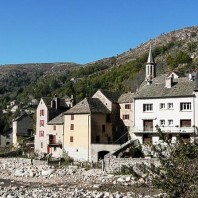The Protestant uprising in Cevennes
The Protestant uprising in Cevennes took place three centuries ago. The rugged and isolated Cévennes hills in south-central France was the venue for a bitter conflict, the severity of which raised eyebrows among the landed classes and nascent bourgeoisie of Northern Europe and beyond.
The Protestant uprising in Cevennes manifested itself as a religious war between French Calvinist Protestants or Huguenots, and their Catholic persecutors, but was really a fight for economic and political power between two opposing ethnic groups and their corresponding worldviews and lifestyles.
In many ways, then, The Protestant uprising in Cevennes can be seen as a precursor to the American Civil War, for in each case The new ‘Spirit of Capitalism’ came into conflict with reactionary forces seeking to maintain a feudal way of life. This new flame was partially extinguished in France; and with a 2007 survey demonstrating that only one third of the French believed in Capitalism, you could argue that the spirit has never been fully accepted. Not the case in the US, of course, where slavery and feudalism were soundly defeated.
As Time magazine opined in a September 1960 article entitled ‘Camisards Revisited’, whilst Protestants are massively outnumbered by Catholics in modern-day France, in 1560 they were four million strong, or twenty-five percent of the population.
The article continues, “for nearly 40 years the two faiths were embroiled in bloody conflict, symbolized by the infamous St. Bartholomew’s Day Massacre of August 1572, during which perhaps as many as 10,000 Huguenots were murdered.” The events were well documented by writers such as Christopher Marlowe in ‘The Massacre at Paris’ and Alexandre Dumas in his 1845 novel, ‘La Reine Margot’, recently popularised in the 1994 French film of the same name that starred Isabelle Adjani.
That slaughter was restricted mainly to Paris and a few larger provincial cities. The origin of the ‘Cévenol’ struggle was the 1598 Edict of Nantes passed by the French Protestant King Henri IV. This not only restored internal peace, but gave the French Protestants a virtual state within a state, legitimising Protestant control over some 200 cities. His successor after 1665, the Sun King himself, Louis XIV, was persuaded by his Roman Catholic advisers to embark on a policy of persecuting the Protestants.
The Peace of Alais (sic), signed in 1629, (now spelt Alès, the gateway to the Cévennes) marked the end of Huguenot political privileges. When the Edict of Nantes was finally revoked in 1685, the policy of forcibly converting Protestants to Catholicism by the ‘Dragonades’ commenced. This took the form of an officially sanctioned repression, the forced clearings from some villages of all men and the billeting of soldiers from the King’s army of ‘Black Dragons’ inside Protestant homes.
Of course the majority of Huguenots tradesmen fled France for refuge in northern Europe, taking their much-needed skills with them. Louis tried to prevent the brain-drain, but failed. The influence on the European silk industry resulting from the Revocation of the Edict of Nantes can be seen in The History of Silk Production.
What became known as the ‘Camisard Revolt’ or ‘War’ began with the assassination at Pont-de-Montvert in July 1702 of a local personification of Royal repression, the Abbot of Chaïla, who had imprisoned a group of Huguenots caught attempting to flee France. It was the spark that lit the blue touch paper for the Cévenol Protestants or ‘Camisards’ – an epithet believed to originate from the Occitan word for shirt, ‘camisa’, the dark uniform worn by the rebels during night raids. This regional Occitan language, experiencing something of a rebirth today, gave Protestants some freedom of thought and expression vis-à-vis the central authorities, although they wrote and prayed in French.
The Camisards confronted the royal army with irregular tactics, or what some historians have described as the first examples of guerilla warfare. They withstood superior forces in several pitched battles and gained some notable successes. The Catholic Encyclopedia (1913) refers to The Camisards as “A sect of French fanatics” whose origins lay in the “Albigensian spirit.” This reference harkens back to the Cathar Crusade against ‘heretics’ in the same Region half a century earlier.
During the Protestant uprising in Cevennes, there seems no doubt that some of the Protestant preaching was apocalyptic and inflammatory, and was used as justification for intensifying repression; some of which was ‘outsourced’ to Catholics from neighboring communities known as “Cadets of the Cross.” Atrocities took place on both sides. The worst of the fighting occurred between 1702 and 1704, with sporadic skirmishes until 1710, and the end of real hostilities in 1715. This followed the death of Louis XIV and the arrival in the Cévennes of the French reformer, Antoine Court, who played a critical role in restructuring the Protestant population and faith.
© The Enlightened Traveller 2020
Francophile hikers with a penchant for themed walking holidays in France, can re-live the main events, visit key locations and learn about the principal personalities in play during the course of the rebellion by clicking to visit our Walking in Cevennes hiking tour.
![]()

 Click to visit The French Hiker’s Guide to Holidaying in the Hexagon and France self-guided walking, trips, trails, places & themes.
Click to visit The French Hiker’s Guide to Holidaying in the Hexagon and France self-guided walking, trips, trails, places & themes.
